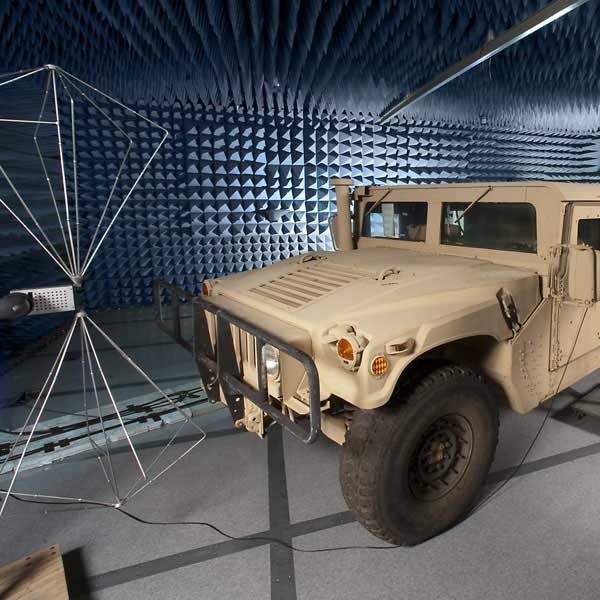Achieving MIL-STD-461 Certification. Lets explores the intricacies of MIL-STD-461 certification, a crucial standard for ensuring electromagnetic compatibility (EMC) in military equipment. As military systems become increasingly reliant on electronic components, achieving EMC is vital to prevent interference and malfunctions. This paper outlines the steps and requirements for obtaining MIL-STD-461 certification, shedding light on the process and benefits of compliance.
Introduction: In today’s technologically advanced landscape, military equipment heavily depends on electronic systems to ensure accuracy, communication, and operational success. However, the proliferation of electronics has brought about new challenges, particularly regarding electromagnetic interference (EMI) and compatibility. Military systems must function seamlessly amidst a sea of electronic devices, both within their own unit and within the broader electromagnetic environment. MIL-STD-461 certification is a cornerstone of achieving electromagnetic compatibility in military equipment.
Understanding MIL-STD-461 Certification: MIL-STD-461, titled “Requirements for the Control of Electromagnetic Interference Characteristics of Subsystems and Equipment,” is a United States military standard that outlines the requirements for evaluating and ensuring the electromagnetic compatibility of electronic subsystems and equipment. This certification is crucial for guaranteeing that military systems can operate effectively without being adversely affected by, or causing interference to, other systems.

Steps to Achieve MIL-STD-461 Certification:
- Identifying Applicability: The first step is to determine whether MIL-STD-461 certification is relevant to the equipment under consideration. Certain types of military equipment, especially those that contain electronic components, fall under the purview of this standard.
- Requirements Analysis: Careful examination of the specific requirements outlined in MIL-STD-461 is essential. This involves understanding the various test methods and limits prescribed by the standard. These tests cover a wide range of electromagnetic phenomena, including radiated emissions, conducted emissions, susceptibility to electromagnetic fields, and more.
- Design Considerations: Integrating EMC considerations into the design phase of the equipment is paramount. This includes implementing proper shielding, grounding, and filtering techniques to minimize electromagnetic emissions and susceptibility.
- Pre-Compliance Testing: Before undergoing formal testing, it is advisable to conduct pre-compliance testing. This helps identify potential issues and provides an opportunity to rectify them prior to official certification testing.
- Formal Testing: MIL-STD-461 testing involves subjecting the equipment to a battery of tests designed to simulate various electromagnetic environments. These tests evaluate emissions and susceptibility, ensuring the equipment’s ability to operate reliably in real-world scenarios.
- Documentation and Reporting: Comprehensive documentation of the testing process and results is necessary for compliance. This documentation provides evidence of adherence to the standard and facilitates future audits.
- Correction of Non-Compliance: In the event that the equipment does not meet the requirements, necessary modifications should be made to rectify non-compliance issues. Subsequent testing might be required to verify the effectiveness of these modifications.
- Final Certification: Once all requirements are met, and the equipment demonstrates compatibility within the electromagnetic environment, MIL-STD-461 certification can be obtained. This certification signifies that the equipment adheres to the stringent EMC standards outlined by the military.
Benefits of Achieving MIL-STD-461 Certification:
- Operational Reliability: Certified equipment exhibits enhanced reliability in diverse electromagnetic environments, ensuring that military operations are not compromised by electromagnetic interference.
- Interoperability: EMC compliance minimizes the risk of interference with other electronic systems, promoting efficient communication and coordination among different military units.
- Regulatory Compliance: Many military contracts and procurement processes require adherence to specific standards like MIL-STD-461. Certification ensures compliance with these contractual obligations.
- Long-Term Cost Savings: By identifying and addressing EMC issues early in the design phase, the likelihood of costly retrofitting or redesigning later on is reduced.
Conclusion: In an era where military capabilities are heavily reliant on electronics, achieving MIL-STD-461 certification is an essential step in ensuring the electromagnetic compatibility of military equipment. By meticulously adhering to the steps outlined in this paper, manufacturers and designers can navigate the complexities of this standard, enhancing operational reliability and mission success for military systems.
References:
- MIL-STD-461G, “Requirements for the Control of Electromagnetic Interference Characteristics of Subsystems and Equipment,” Department of Defense, 2015.
- Giri, D., & Singh, D. (2016). Electromagnetic Interference and Compatibility Challenges for Military Systems. Defence Science Journal, 66(6), 631-637.
- Thomas, R. M. (2019). Electromagnetic Compatibility Engineering. John Wiley & Sons.
- Federal Standard 1037C, “Telecommunications: Glossary of Telecommunication Terms,” General Services Administration, 1996.





